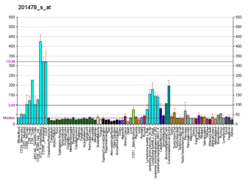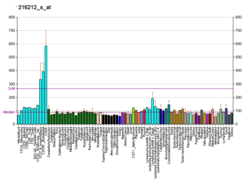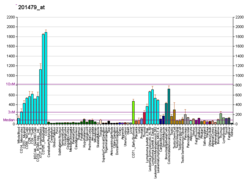Dyskerin
H/ACA ribonucleoprotein complex subunit 4 is a protein that in humans is encoded by the gene DKC1.[5][6][7]
This gene is a member of the H/ACA snoRNPs (small nucleolar ribonucleoproteins) gene family. snoRNPs are involved in various aspects of rRNA processing and modification and have been classified into two families: C/D and H/ACA. The H/ACA snoRNPs also include the NOLA1, 2 and 3 proteins. The protein encoded by this gene and the three NOLA proteins localize to the dense fibrillar components of nucleoli and to coiled (Cajal) bodies in the nucleus. Both 18S rRNA production and rRNA pseudouridylation are impaired if any one of the four proteins is depleted. The protein encoded by this gene is related to the Saccharomyces cerevisiae Cbf5p and Drosophila melanogaster Nop60B proteins. The gene lies in a tail-to-tail orientation with the palmitoylated erythrocyte membrane protein (MPP1) gene and is transcribed in a telomere to centromere direction. Both nucleotide substitutions and single trinucleotide repeat polymorphisms have been found in this gene. Mutations in this gene cause X-linked dyskeratosis congenita.[7]
Clinical significance
Mutations in DKC1 are associated to Hoyeraal-Hreidarsson syndrome.[8]
References
- ^ a b c GRCh38: Ensembl release 89: ENSG00000130826 – Ensembl, May 2017
- ^ a b c GRCm38: Ensembl release 89: ENSMUSG00000031403 – Ensembl, May 2017
- ^ "Human PubMed Reference:". National Center for Biotechnology Information, U.S. National Library of Medicine.
- ^ "Mouse PubMed Reference:". National Center for Biotechnology Information, U.S. National Library of Medicine.
- ^ Heiss NS, Knight SW, Vulliamy TJ, Klauck SM, Wiemann S, Mason PJ, Poustka A, Dokal I (May 1998). "X-linked dyskeratosis congenita is caused by mutations in a highly conserved gene with putative nucleolar functions". Nat Genet. 19 (1): 32–8. doi:10.1038/ng0598-32. PMID 9590285.
- ^ Hassock S, Vetrie D, Giannelli F (Mar 1999). "Mapping and characterization of the X-linked dyskeratosis congenita (DKC) gene". Genomics. 55 (1): 21–7. doi:10.1006/geno.1998.5600. PMID 9888995.
- ^ a b "Entrez Gene: DKC1 dyskeratosis congenita 1, dyskerin".
- ^ Lim, B. C.; Yoo, S. K.; Lee, S; Shin, J. Y.; Hwang, H; Chae, J. H.; Hwang, Y. S.; Seo, J. S.; Kim, J. I.; Kim, K. J. (2014). "Hoyeraal-Hreidarsson syndrome with a DKC1 mutation identified by whole-exome sequencing". Gene. 546 (2): 425–9. doi:10.1016/j.gene.2014.06.011. PMID 24914498.
Further reading
- Marrone A, Dokal I (2004). "Dyskeratosis congenita: molecular insights into telomerase function, ageing and cancer". Expert Reviews in Molecular Medicine. 6 (26): 1–23. doi:10.1017/S1462399404008671. PMID 15613268.
- Yamaguchi H (2007). "Mutations of telomerase complex genes linked to bone marrow failures". Journal of Nippon Medical School. 74 (3): 202–9. doi:10.1272/jnms.74.202. PMID 17625368.
- Aalfs CM, van den Berg H, Barth PG, Hennekam RC (1995). "The Hoyeraal-Hreidarsson syndrome: the fourth case of a separate entity with prenatal growth retardation, progressive pancytopenia and cerebellar hypoplasia". Eur. J. Pediatr. 154 (4): 304–8. doi:10.1007/BF01957367. PMID 7607282.
- Maruyama K, Sugano S (1994). "Oligo-capping: a simple method to replace the cap structure of eukaryotic mRNAs with oligoribonucleotides". Gene. 138 (1–2): 171–4. doi:10.1016/0378-1119(94)90802-8. PMID 8125298.
- Devriendt K, Matthijs G, Legius E, et al. (1997). "Skewed X-chromosome inactivation in female carriers of dyskeratosis congenita". Am. J. Hum. Genet. 60 (3): 581–7. PMC 1712491. PMID 9042917.
- Suzuki Y, Yoshitomo-Nakagawa K, Maruyama K, et al. (1997). "Construction and characterization of a full length-enriched and a 5'-end-enriched cDNA library". Gene. 200 (1–2): 149–56. doi:10.1016/S0378-1119(97)00411-3. PMID 9373149.
- McGrath JA (1999). "Dyskeratosis congenita: new clinical and molecular insights into ribosome function". Lancet. 353 (9160): 1204–5. doi:10.1016/S0140-6736(99)00011-2. PMID 10217077.
- Knight SW, Heiss NS, Vulliamy TJ, et al. (1999). "X-linked dyskeratosis congenita is predominantly caused by missense mutations in the DKC1 gene". Am. J. Hum. Genet. 65 (1): 50–8. doi:10.1086/302446. PMC 1378074. PMID 10364516.
- Vulliamy TJ, Knight SW, Heiss NS, et al. (1999). "Dyskeratosis congenita caused by a 3' deletion: germline and somatic mosaicism in a female carrier". Blood. 94 (4): 1254–60. PMID 10438713.
- Heiss NS, Girod A, Salowsky R, et al. (2000). "Dyskerin localizes to the nucleolus and its mislocalization is unlikely to play a role in the pathogenesis of dyskeratosis congenita". Hum. Mol. Genet. 8 (13): 2515–24. doi:10.1093/hmg/8.13.2515. PMID 10556300.
- Knight SW, Heiss NS, Vulliamy TJ, et al. (2000). "Unexplained aplastic anaemia, immunodeficiency, and cerebellar hypoplasia (Hoyeraal-Hreidarsson syndrome) due to mutations in the dyskeratosis congenita gene, DKC1". Br. J. Haematol. 107 (2): 335–9. doi:10.1046/j.1365-2141.1999.01690.x. PMID 10583221.
- Mitchell JR, Wood E, Collins K (1999). "A telomerase component is defective in the human disease dyskeratosis congenita". Nature. 402 (6761): 551–5. doi:10.1038/990141. PMID 10591218.
- Yaghmai R, Kimyai-Asadi A, Rostamiani K, et al. (2000). "Overlap of dyskeratosis congenita with the Hoyeraal-Hreidarsson syndrome". J. Pediatr. 136 (3): 390–3. doi:10.1067/mpd.2000.104295. PMID 10700698.
- Heiss NS, Bächner D, Salowsky R, et al. (2000). "Gene structure and expression of the mouse dyskeratosis congenita gene, dkc1". Genomics. 67 (2): 153–63. doi:10.1006/geno.2000.6227. PMID 10903840.
- Pogacić V, Dragon F, Filipowicz W (2000). "Human H/ACA Small Nucleolar RNPs and Telomerase Share Evolutionarily Conserved Proteins NHP2 and NOP10". Mol. Cell. Biol. 20 (23): 9028–40. doi:10.1128/MCB.20.23.9028-9040.2000. PMC 86556. PMID 11074001.
- Hartley JL, Temple GF, Brasch MA (2001). "DNA Cloning Using In Vitro Site-Specific Recombination". Genome Res. 10 (11): 1788–95. doi:10.1101/gr.143000. PMC 310948. PMID 11076863.
- Simpson JC, Wellenreuther R, Poustka A, et al. (2001). "Systematic subcellular localization of novel proteins identified by large-scale cDNA sequencing". EMBO Rep. 1 (3): 287–92. doi:10.1093/embo-reports/kvd058. PMC 1083732. PMID 11256614.
- Knight SW, Vulliamy TJ, Morgan B, et al. (2001). "Identification of novel DKC1 mutations in patients with dyskeratosis congenita: implications for pathophysiology and diagnosis". Hum. Genet. 108 (4): 299–303. doi:10.1007/s004390100494. PMID 11379875.
External links







